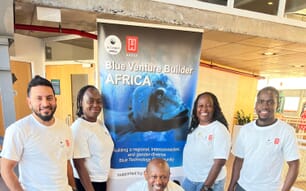Identity
Cirrhinus mrigala Hamilton, 1822 [Cyprinidae]
FAO Names: En - Mrigal carp, Fr - , Es -
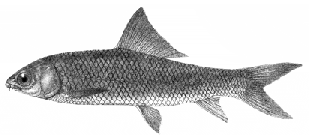
Biological features
Body bilaterally symmetrical and streamlined, its depth about equal to length of head; body with cycloid scales, head without scales; snout blunt, often with pores; mouth broad, transverse; upper lip entire and not continuous with lower lip, lower lip most indistinct; single pair of short rostral barbels; pharyngeal teeth in three rows, 5.4.2/2.4.5 pattern; lower jaw with a small post-symphysial knob or tubercle; origin of dorsal fin nearer to end of snout than base of caudal; dorsal fin as high as body with 12 or 13 branched rays; last unbranched ray of dorsal fin non-osseous and non-serrated; pectoral fins shorter than head; caudal fin deeply forked; anal fin not extending to caudal fin; lateral line with 40-45 scales; lateral transverse scale rows 6-7/5½-6 between lateral line and pelvic fin base; usually dark grey above, silvery beneath; dorsal fin greyish; pectoral, pelvic and anal fins orange-tipped (especially during breeding season).
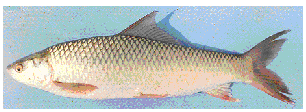
Profile
Historical background
Mrigal (Cirrhinus mrigala), a carp endemic to Indo-Gangetic riverine systems, is one of the three Indian major carp species cultivated widely in Southeast Asian countries. This species has long been important in polyculture with other native species, mainly in India. However, records of its culture are available only from the early part of the 20th century. The traditional culture of the species was restricted to eastern parts of India until the 1950s. The technology of artificial propagation, which assured seed supply in the 1960s, led to the foundation of scientific carp culture. The initially higher growth rate of mrigal, coupled with its compatibility with other carps, has helped in establishing this species as one of the principal component species in pond culture. The species was transplanted in the peninsular riverine systems of India, where it has established itself. Subsequently it has spread over whole of India. In addition, mrigal has become an important component in the fish culture systems of Bangladesh, Pakistan, Myanmar, the Lao People's Democratic Republic, Thailand and Nepal. Mrigal has also been introduced into Sri Lanka, Vietnam, China, Mauritius, Japan, Malaysia, Philippines and the former USSR.
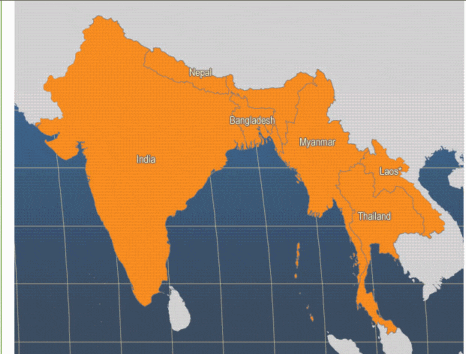
* the Lao People's Democratic Republic
Habitat and biology
Hatchlings of mrigal normally remain in the surface or sub-surface waters, while fry and fingerling tend to move to deeper water. Adults are bottom dwellers.It is an illiophage in its feeding habit and stenophagous; detritus and decayed vegetation form its principal food components, while phytoplankton and zooplankton comprise the rest.
Mrigal is eurythermal, appearing to tolerate a minimum temperature of 14 ºC. In culture, the species normally attains 600-700 g in the first year, depending on stocking density and management practices. Among the three Indian major carps, mrigal normally grows more slowly than catla and rohu. The rearing period is usually confined to a maximum of two years, as growth rate reduces thereafter. However, mrigal is reported to survive as long as 12 years in natural waters.
Maturity is attained in two years in captivity. As mrigal needs a fluviatile environment for breeding it does not breed in ponds. However, captive breeding in hatcheries has been made possible through induced breeding by hypophysation and the use of synthetic hormones.
Mrigal is a highly fecund fish. Fecundity increases with age, and normally ranges from 100 000-150 000 eggs/kg BW. The spawning season depends upon the onset and duration of the south-west monsoon, which in India, Bangladesh and Pakistan extends from May to September. Mrigal usually breeds at 24-31 ºC.
Production
Production cycle
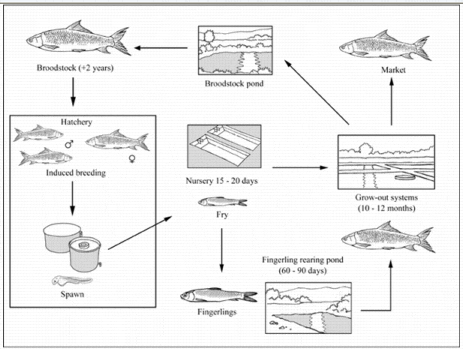
Production systems
Mrigal is cultured mainly as a component of carp polyculture systems in the ponds of India and Bangladesh, the major producing countries. The Lao People's Democratic Republics, Thailand, Vietnam, Pakistan, Myanmar and Nepal also use mrigal as one of the principal components in carp polyculture systems. Mrigal is normally cultured along with the other two Indian major carps - catla (Catla catla) and rohu (Labeo rohita). It is also cultured in composite carp culture systems that include the three Indian major carps as well as two Chinese carps - silver carp (Hypophthalmichthys molitrix) and grass carp (Ctenopharyngodon idella) - and common carp (Cyprinus carpio). Being a bottom feeder, mrigal is usually stocked at 20-30 per cent of the total species stocked in three-species culture, while in six-species culture mrigal constitutes only about 15-20 per cent. In India, carp is cultured in about 900 000-1 000 000 ha of ponds and 'tanks' (water bodies that are usually larger than a pond but less than 10 ha) that are privately or community owned. In Bangladesh, however, carp farming is carried out mostly in small traditional ponds, of which only about 16 per cent are semi-intensive.
Seed supply
Mass scale seed production of mrigal in hatcheries through induced breeding now supplies almost the entire seed requirement in all the producing countries, although riverine collection still forms the source of seed in certain small areas. As mrigal does not breed in confined waters, injections of pituitary extract and other synthetic commercial formulations of purified salmon gonadotropin and dopamine antagonists such as Ovaprim, Ovatide and Wova-FH have also been successfully used in recent years. When pituitary extract is used, females are injected with a stimulating dose of 2-3 mg/kg BW followed by a second dose of 5 to 8 mg/kg after a lapse of 6 hours; males are given a single dose of 2-3 mg/kg at the time of second injection of the female. When synthetic formulations are used, a single dose of 0.4-0.5 ml/kg BW (females) or 0.2-0.3 ml/kg (males) is administered. The spawn recovery of mrigal usually ranges from 100 000 to 150 000/kg. The Chinese circular hatchery is the most common system used. In this system, broodstock are kept at 3-5 kg /m3, with a 1:1 female:male stocking ratio by weight (1:2 by number). Fertilized eggs are obtained after 6-8 hours and are transferred to the hatching tank, optimally stocked at 700 000-800 000/m3. Water circulation is continuous and the eggs are retained until 72 hours, during which the embryos develop into hatchlings of about 6 mm.
Nursery phase
Three-day old hatchlings are reared in a nursery system for a period of 15-20 days till they become fry of 20-25 mm. Small earthen ponds of 0.02-0.1 ha are normally employed, though brick-lined or cement tanks are used in certain areas. The stocking density usually ranges from 3-10 million/ha in earthen ponds and 10-20 million/ha in brick or cement tanks. Though monoculture is advocated for nursery rearing, farmers often raise mrigal along with the other two Indian major carps. In these cases, the growth and survival of mrigal is higher than the other two. The other management measures include organic manuring and fertilisation, and the provision of a mixture of rice bran and oil cake (1:1 w/w) as a supplementary feed. Survival normally ranges from 30-50 percent. Good pre-stocking nursery pond preparation includes control over predatory and weed fish, and insects. Farmers often neglect such procedures, resulting in low fry production. Another limiting factor is the non-availability of commercial feed, which forces farmers to resort to the conventional bran-oilcake mixture.
Fingerling production
The fry from the nursery system are further raised to fingerling size (80-100 mm; 5-10 g). Earthen ponds ranging from 0.05 to 0.2 ha are commonly used. Although monoculture is advocated in the nursery phase, in fingerling rearing mrigal are stocked at about 30 per cent and cultured along with other carp species at a combined density of about 200 000-300 000/ha. Feeding and fertilization regimes are similar to the nursery phase but vary according to the intensity of culture and the natural productivity. Overall survival in the fingerling rearing stage ranges from 60 to 70 per cent; generally, mrigal has a higher survival level than catla and rohu. Fish are reared in this phase for 2-3 months, after which they are transferred to grow-out production systems.
Ongrowing techniques
The grow-out culture of mrigal in polyculture systems is confined to earthen ponds and normal management practice includes predatory and weed fish control with chemicals or plant derivatives; stocking of fingerlings at a combined density of 4 000-10 000 fingerlings/ha; fertilization with organic manures like cattle dung or poultry droppings and inorganic fertilisers; supplementary feeding with a mixture of rice bran/wheat bran and oil cake; and fish health monitoring and environmental management. The grow-out period is usually one year, during which mrigal grows to about 600-700 g. Production is normally 3-5 tonnes/ha/yr, with mrigal contributing about 20-25 percent.
The lack of fingerlings of suitable size in adequate quantities is the most important limiting factor, compelling farmers to stock ponds with fry instead of fingerlings. High prices for commercial feeds and feed ingredients often restrain farmers from feeding at the proper level, thus limiting production.
Mrigal also forms one of the important components in the sewage-fed carp culture system practiced in an area totalling over 4000 ha in West Bengal, India. In this form of culture, which includes multiple stocking and multiple harvesting of fish larger than 300 g, primary treated sewage is provided to the fish ponds as the main input. Even without the provision of supplementary feed, this system produces 2-3 tonnes/ha/yr. With supplementary feeding, this can be increased to 4-5 tonnes/ha/yr.
Harvesting techniques
The bottom dwelling habit of mrigal hinders its effective harvesting by dragnet, the most common gear used in carp culture. Complete harvesting is possible only through draining. These harvesting difficulties make mrigal the least preferred species among the three Indian major carps for farmers. Cast nets are often used for partial harvesting in small and backyard ponds.
Handling and processing
The species is mostly marketed fresh in local markets. However, long distance transport of mrigal with other carps packed with crushed ice at 1:1 ratio in rectangular plastic crates (60 cm x 40 cm x 23 cm) in insulated vans is often practiced in India. Post-harvest processing and value-addition is almost non-existent at present in any of the producing countries. During recent years a small quantity of Indian major carps is being exported from India to the Middle East, degutted and frozen.
Diseases and control measures
In some cases antibiotics and other pharmaceuticals have been used in treatment but their inclusion in this table does not imply an FAO recommendation.
| DISEASE | AGENT | TYPE | SYNDROME | MEASURES |
|---|---|---|---|---|
| Ulcer | Aeromonas spp.; Pseudomonas spp. | Bacteria | Ulcerations; exophthalmia; abdominal distension | Destroy badly infected fish; disinfect affected ponds with 0.5 ppm solution of KMnO4; add sulphadiazine (100 mg/kg) or terramycin (75-80 mg/kg) to feed for 10-12 days |
| Columnaris | Flavobacterium columnaris | Bacterium | Raised white plaques, often with reddish peripheral zone leading to haemorrhagic spots on body | Dip treatment with 500 ppm KMnO4 |
| Dropsy | Aeromonas sp. | Bacterium | Body scales stretch out resembling pine cone; inflammation; ulceration; exophthalmia; abdominal distension | Disinfect affected ponds with 1 ppm KMnO4; dip treatment of 5 ppm KMnO4 for 2 minutes |
| Saprolegniasis | Saprolegnia parasitica | Fungus | Mould grows like cotton wool on body, penetrating into the muscle; morbid muscle rot | 3-4 per cent NaCl bath; 160 mg/litre KMnO4 bath for 5 days; 1-2 mg/litre malachite green bath for 30 minutes to 1 hour; add formalin at 20 ml/litre to affected ponds |
| Branchiomyosis (gill rot) | Branchiomyces demigrans | Fungus | Fungus grows out through gill blood vessels and causes necrosis of surrounding tissues; yellow-brown discolouration & disintegration of gill tissues | Addition of quick lime (50-100 kg/ha) to affected ponds; in case of limited infections, use 3-5 per cent NaCl bath for 5-10 minutes, or 5 ppm KMnO4 bath for 5-10 minu |
| Ichthyophthiriasis | Ichthyophthirius multifilis | Parasite(protozoan) | Skin, fin rays & operculum covered with white spores; sick fish keep rubbing against hard substratum | Dip in 1:5000 formalin solution for 1 hour for 7-10 days or in 2 per cent NaCl for 7-10 days; affected ponds should be disinfected with quicklime at 200 kg/ha |
| Trichodiniasis | Thenohanellus catlae;Myxobolus bengalensis; M. catlae; M. hosadurgensis | Parasites(protozoan) | Weakness; emaciation; raising of scales along their posterior margins; scale loss; perforation of scales; loss of chromatophores | Reduce density; add yeast to feed (1 g/kg); 2-3 per cent NaCl bath |
| Dactylogyrosis and Gyrodactylosis | Dactylogyrus spp.; Gyrodactylus spp. | Parasites(monogenean trematodes) | Gill, fin & skin affected; excessive mucus secretion | 3-5 per cent NaCl dip treatment for 5-10 minutes; 100 ppm formalin bath; treat affected ponds with 25 ppm formalin or 4 ppm KMnO4 |
| Black spot or Diplostomiasis | Diplostomum pigmentata | Parasites (digenean trematode) | Black nodules due to metacercarial cysts in the host body; infects eye and causes blindness | Remove resident molluscan population |
| Argulosis | Argulus sp. | Parasite (crustacean) | Parasites visible to naked eye attached to head & fin rays; haemorrhagic spots found in chronic cases | Drain and dry ponds showing severe Argulus infection; short duration 5 ppm KMnO4 dip; treatment with 'Butox' three times at 35 ml/ha-m at weekly intervals |
| Epizootic Ulcerative Syndrome | Aeromonas hydrophila; A. sorbia; Aphanomyces invadans | Bacteria and fungus | Large red or grey shallow ulcers with necrotic areas on skin; fungus extends deep into the musculature; lesions of acute dermatitis and ulcers | 200 kg/ha quicklime or 0.1 ppm CIFAX (a CIFA, India formulation) |
Suppliers of pathology expertise
The following are examples of locations where expertise can be accessed:
- Central Institute of Freshwater Aquaculture, India.
- Central Institute of Fisheries Education, Mumbai, India.
- College of Fisheries, Mangalore, India.
Statistics
Production statistics
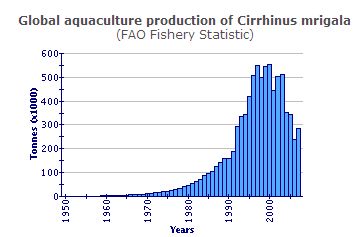
After fairly rapid expansion up to 1996, total global mrigal production was relatively steady between 1996-2003, with peaks of 552 000 tonnes in 2000 and 445 000 tonnes in 2001. India is by far the largest producer of mrigal but Bangladesh is also a major producer. The Lao People's Democratic Republic, Thailand and Myanmar also produce this species. Non-species-specific production statistics in several other countries has been a major constraint in assessing the actual farmed production of mrigal but it is known to be reared in Pakistan and Nepal.
Market and trade
In all the producing countries, almost all farmed mrigal is consumed in the local market. Governmental regulations and controls over the domestic marketing system are almost non-existent in these countries and demand and supply thus influence product value. Being the least preferred among the three Indian major carps, mrigal fetches comparatively low market prices, usually fetching 10-20 percent less than rohu or catla. However, consumer preference makes the prices obtained for these species always higher than those for common carp and Chinese carps.
Status and trends
Several factors have enhanced the status of the farming of the Indian major carps:
- Improvements in induced breeding and seed production, which have removed the reliance on the capture of natural riverine seed.
- Improved grow-out technology.
- Improvements in feeding and health management.
On the other hand, while the inter-generic hybridisation of mrigal, rohu, catla, grass carp and common carp has been attempted, the hybrids did not show any genetic advantage over the parent stocks.
Other factors have caused problems. The adoption of intensive farming practices, unregulated use of inputs and lack of scientific know-how among the farmers has led to increased disease incidence. However, continued thrust on health management leading to development of therapeutics has helped the sector to overcome from such situations.
India has already drawn up a strategic plan for doubling freshwater aquaculture production through increases in productivity and area. Since mrigal forms an important component of the carp polyculture system, it can be expected that there will be a two-fold increase in its production in India by 2015. Bangladesh is also expected to enhance farmed mrigal production. The high growth potential of the Indian major carps has attracted the attention of several tropical South-Eastern Asian and Middle-Eastern countries.
Other factors are expected to influence further growth in the farming of Indian major carps, including:
- Selective breeding.
- Organic fish farming.
- Export to South-East Asian and Middle-East countries.
- Development of processing and value-added products.
The official production figures often do not represent a true picture, due to the lack of appropriate and uniform data collection mechanisms. The inadequate production statistical database has been an important drawback for the formulation of strategic development plans. The available information from several countries represents the total carp production, rather than that of individual species. Thus, uniform guidelines for database development would, to a great extent, help in the assessment of actual production and in the development of plans for the future.
Main issues
Carps are generally cultured in a closed system that involves herbivorous species, in which organic materials are used as the principal input sources, thereby making it a generally environmentally-friendly practice. Furthermore, the compatibility of mrigal in polyculture systems with regard to habitat preference and feeding habits is good. However, the tendency of farmers to increase income per unit area has led to an excessive use of fertilizers, proteinaceous feeds and chemicals that may have detrimental effects on the environment. The compatibility of mrigal in polyculture systems with other carps has already been established. However, being a bottom dweller, the harvesting of this species is a perpetual problem, especially in undrainable ponds.
Responsible aquaculture practices
Being a low input-based system, carp culture has not generally been perceived as a threat to the environment. However, increased emphasis on intensification for enhancing production in recent years has resulted in increased use of chemical fertilizers, feeds, therapeutics, drugs, chemicals, etc., which pose some concern. It is therefore necessary that the practicing countries should formulate guidelines and impose strict regulatory measures for the judicious use of these critical inputs. Application of the principles of Article 9 of the FAO Code of Conduct for Responsible Fisheries would be appropriate.
December 2009




